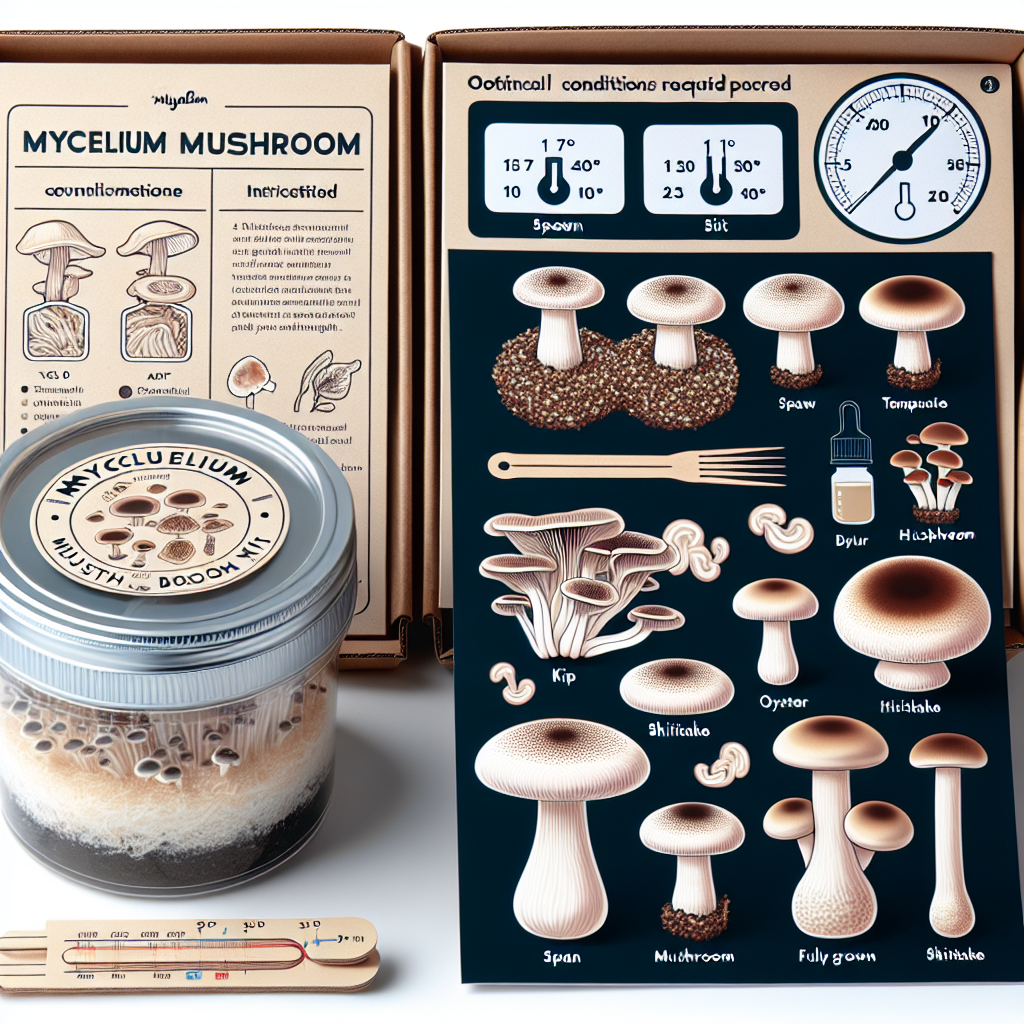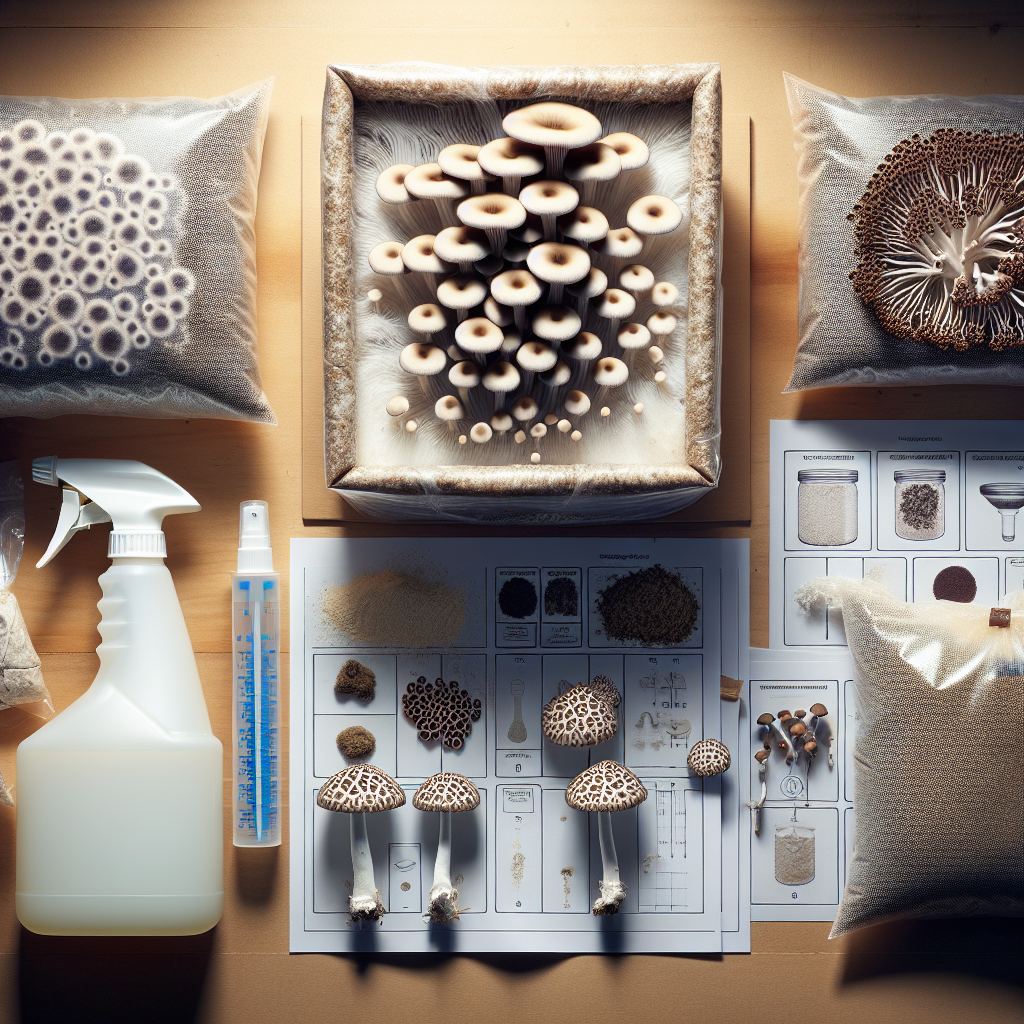As an enthusiast eager to embark on the fascinating journey of mushroom cultivation, understanding the intricacies of mycelium mushroom kits will prove to be a valuable asset. Armed with the insights from “Mycelium Mushroom Kit: A Comprehensive Guide,” you’ll grasp not only the fundamentals but also the finer points to mastering this craft. This guide will lead you step by step through the diverse world of mycelium, detailing everything from selecting the most suitable kit to expert tips for optimal mushroom growth.

Understanding Mycelium Mushroom Kit
Growing your own mushrooms can be a rewarding practice, providing both a source of fresh food and a fascinating window into a less understood aspect of nature. The key to successful mushroom cultivation lies beneath the earth: mycelium. To facilitate this, the Mycelium Mushroom Kit has been designed to ensure anyone can enjoy the process and the product from the comfort of their homes.
Definition of Mycelium
Mycelium is the vegetative part of a fungus that consists of a network of fine, white filaments. It’s critical in the mushroom cultivation process as mushrooms are the fruiting bodies of this underground network. Simply put, mycelium is to mushrooms what roots are to a tree. Understanding this component is essential before delving into the world of mushroom cultivation.
What a Mycelium Mushroom Kit includes
A Mycelium Mushroom Kit simplifies the process of growing mushrooms. The kit typically includes a growing medium such as grain or wood chips already colonized by mycelium, instructions for cultivation, a grow bag for maintaining humidity, and in some cases, a spray bottle for watering. This all-in-one package alleviates the need for complex sterilization processes and sourcing mycelium, allowing anyone to grow mushrooms with ease.
Benefits of Using Mycelium Mushroom Kits
The benefits of using a mycelium mushroom kit are numerous, ranging from ease of use to controlled yields.
Easy to use for beginners
One of the most attractive attributes of a mycelium mushroom kit is its accessibility to even the most novice grower. Rooted in simplicity, the kits are accompanied by clear instructions that require no prior horticultural expertise, paving the way for successful mushroom cultivation.
Controlled fungal growth
A major advantage of mycelium mushroom kits is the controlled growth environment. The prepared substrate within the kit has been colonized solely by the desired fungal species, minimizing the threat posed by competing organisms typically found in outdoor environments.
Increased yields
Mycelium mushroom kits are designed to maximize yield. Utilizing heights of scientific knowledge and cultivation expertise, these kits are optimized for productive growth, ensuring plentiful harvests.
Reduced chance of contamination
One of the biggest challenges in mushroom cultivation is contamination. Mycelium mushroom kits are typically prepared in sterile conditions, significantly reducing the likelihood of unfavourable organisms taking root.
Types of Mycelium Mushroom Kits
Mushroom kits come in a variety of types, suited to different needs and interests.
Gourmet mushroom kits
Gourmet mushroom kits allow growers to cultivate high-end mushroom varieties, such as oyster and shiitake, fresh in their homes. These kits make growing quality mushrooms possible without needing a large garden or specialized knowledge.
Medicinal mushroom kits
Medicinal mushroom kits cater to growers interested in cultivating mushrooms known for their medicinal properties, such as Reishi and Lion’s Mane. These kits provide an opportunity to grow these specialized mushrooms in a controlled environment, facilitating their optimal medicinal potency.

How to Use a Mycelium Mushroom Kit
Using a Mycelium Mushroom Kit is relatively simple and straightforward, often broken down into a few key steps.
Unpacking the kit
The first step upon receiving your kit usually involves carefully unpacking it and verifying that all the necessary components have been included.
Preparation before use
Next, you may be required to soak the mycelium block to initiate growth. This step, called “cold shocking,” tricks the mycelium into thinking it’s time to fruit.
Following the cultivation instructions supplied with the kit
After the preparation phase, it all comes down to following the instructions included with the kit. This might involve maintaining specific environmental conditions, such as lighting and humidity, for optimal mushroom growth.
Optimizing Mushroom Growth
Suitable environmental conditions
Maintaining suitable environmental conditions is fundamental to mushroom growth. This involves ensuring the temperature, lighting, humidity and fresh air supply fall within the recommended parameters for the particular mushroom species.
Proper watering methods
Watering your mushrooms correctly is vital. While specifics can vary across species, the general principle is to provide adequate moisture without overwatering to prevent waterlogging or promoting mould growth.
Harvesting at the right time
Knowing when to harvest your mushrooms is also important. Typically, mushrooms are ready to harvest just before their caps fully open up, although this depends on the species. Precise timing ensures you enjoy your mushrooms at their best in taste and texture.
Common Technical Problems and Solutions
Delayed or failed mushroom sprouting
Delayed or failed mushroom sprouting might occur due to improper environmental conditions or contamination. If your mushrooms are delayed, ensure environmental conditions are ideal. If they fail to sprout, contamination could be the culprit.
Dealing with mould or other pests
Mold or pests can be managed by maintaining optimal conditions for mushroom growth and unfavorable conditions for pests. If mould appears, it may be necessary to dispose of the entire kit for health and safety.
Mushroom stunting
Stunted growth can often be traced back to inadequate lighting, nutritional deficiencies in the substrate, or unsuitable temperature or humidity. A review of these factors can often help restore normal growth.
Best Practices for Mushroom Cultivation At Home
Home mushroom cultivation has its best practice guidelines to optimize growth.
Choosing the right location for the kit
Location greatly influences growth, with options varying based on species. While some mushrooms grow best in dark, cool spaces, others require a bright room-temperature environment.
Ensuring cleanliness to avoid contamination
Keeping your growing environment clean can’t be overemphasized. Regularly cleaning surfaces, tools, and watering containers may prevent unwanted organisms from creeping in and competing with your mushrooms.
Waiting patiently for the growth cycle to fully complete
Patience is key in mushroom cultivation. Resist the temptation to interfere too much and allow the mushroom life-cycle to run its course. The reward will be fruitful.
The Mushroom Life-Cycle
Understanding the fundamental life-cycle of mushrooms can be immensely helpful in successful cultivation.
Understanding the mushroom life-cycle
The mushroom life-cycle involves spore release, germination, mycelium consolidation, development of the fruiting body (the mushroom), and maturity. Each stage is critical in the overall life cycle and understanding these stages can help when encountering problems.
How the mycelium fits into the life-cycle
Mycelium is the vegetative phase of the life-cycle, producing the network that eventually gives rise to mushrooms under the right conditions.
How kits leverage the life-cycle
Mycelium mushroom kits begin at the mycelium consolidation phase. With the challenging task of successful spore germination and colonization already completed, these kits leverage the mycelium and its life cycle to simplify mushroom cultivation for home growers.
Comparing DIY Methods vs. Using a Mycelium Mushroom Kit
The complexities of DIY methods
Growing mushrooms from scratch requires technical expertise, precise sterilization procedures, and long preparation times. There’s also a high risk of failure due to contamination, making it far more challenging than kit-based cultivation.
Cost comparison
While DIY methods may seem more cost-effective, the hidden costs, including time, potential failures, and equipment, make it less so. Mycelium mushroom kits are an investment towards guaranteed success with minimal effort, making it cost-effective in the long run.
Time and effort comparison
DIY methods are time-consuming and involve a steep learning curve. Conversely, a kit simplifies the process, requiring no specialized knowledge or skills and reducing the time investment significantly.
Success rates
Success rates from DIY methods largely depend on individual skills, equipment, and clean work procedures. Kits afford a higher rate of success because the critical early stages have been professionally handled.
Potential Health Benefits of Cultivating Your Own Mushrooms
Nutritional benefits of mushrooms
Mushrooms are packed with nutrients, including protein, vitamins, minerals, and dietary fibre, making them a healthy addition to any diet.
Potential medicinal properties
Beyond nutrition, certain mushroom species are renowned for their medicinal properties, including boosting immune function, reducing stress, and potentially combating certain types of cancer.
Benefits of growing food at home
Growing your own food can be therapeutic, providing a sense of achievement and connection with nature. It also ensures you know exactly where your food comes from and how it’s been grown. Furthermore, it reduces your carbon footprint linked to food transportation and packaging.
